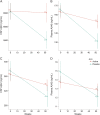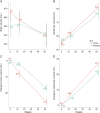A randomized, double-blind, placebo-controlled trial of resveratrol for Alzheimer disease
- PMID: 26362286
- PMCID: PMC4626244
- DOI: 10.1212/WNL.0000000000002035
A randomized, double-blind, placebo-controlled trial of resveratrol for Alzheimer disease
Abstract
Objective: A randomized, placebo-controlled, double-blind, multicenter 52-week phase 2 trial of resveratrol in individuals with mild to moderate Alzheimer disease (AD) examined its safety and tolerability and effects on biomarker (plasma Aβ40 and Aβ42, CSF Aβ40, Aβ42, tau, and phospho-tau 181) and volumetric MRI outcomes (primary outcomes) and clinical outcomes (secondary outcomes).
Methods: Participants (n = 119) were randomized to placebo or resveratrol 500 mg orally once daily (with dose escalation by 500-mg increments every 13 weeks, ending with 1,000 mg twice daily). Brain MRI and CSF collection were performed at baseline and after completion of treatment. Detailed pharmacokinetics were performed on a subset (n = 15) at baseline and weeks 13, 26, 39, and 52.
Results: Resveratrol and its major metabolites were measurable in plasma and CSF. The most common adverse events were nausea, diarrhea, and weight loss. CSF Aβ40 and plasma Aβ40 levels declined more in the placebo group than the resveratrol-treated group, resulting in a significant difference at week 52. Brain volume loss was increased by resveratrol treatment compared to placebo.
Conclusions: Resveratrol was safe and well-tolerated. Resveratrol and its major metabolites penetrated the blood-brain barrier to have CNS effects. Further studies are required to interpret the biomarker changes associated with resveratrol treatment.
Classification of evidence: This study provides Class II evidence that for patients with AD resveratrol is safe, well-tolerated, and alters some AD biomarker trajectories. The study is rated Class II because more than 2 primary outcomes were designated.
© 2015 American Academy of Neurology.
Figures



Similar articles
-
Resveratrol regulates neuro-inflammation and induces adaptive immunity in Alzheimer's disease.J Neuroinflammation. 2017 Jan 3;14(1):1. doi: 10.1186/s12974-016-0779-0. J Neuroinflammation. 2017. PMID: 28086917 Free PMC article. Clinical Trial.
-
Neuroprotective Effect of Trans-Resveratrol in Mild to Moderate Alzheimer Disease: A Randomized, Double-Blind Trial.Neurol Ther. 2021 Dec;10(2):905-917. doi: 10.1007/s40120-021-00271-2. Epub 2021 Aug 16. Neurol Ther. 2021. PMID: 34402024 Free PMC article.
-
Resveratrol for Alzheimer's disease.Ann N Y Acad Sci. 2017 Sep;1403(1):142-149. doi: 10.1111/nyas.13431. Epub 2017 Aug 16. Ann N Y Acad Sci. 2017. PMID: 28815614 Free PMC article. Review.
-
Safety and tolerability of the γ-secretase inhibitor avagacestat in a phase 2 study of mild to moderate Alzheimer disease.Arch Neurol. 2012 Nov;69(11):1430-40. doi: 10.1001/archneurol.2012.2194. Arch Neurol. 2012. PMID: 22892585 Clinical Trial.
-
Safety and pharmacology of a single intravenous dose of ponezumab in subjects with mild-to-moderate Alzheimer disease: a phase I, randomized, placebo-controlled, double-blind, dose-escalation study.Clin Neuropharmacol. 2013 Jan-Feb;36(1):14-23. doi: 10.1097/WNF.0b013e31827db49b. Clin Neuropharmacol. 2013. PMID: 23334070 Clinical Trial.
Cited by
-
Oxidative Stress, Neuroinflammation, and NADPH Oxidase: Implications in the Pathogenesis and Treatment of Alzheimer's Disease.Oxid Med Cell Longev. 2021 Apr 16;2021:7086512. doi: 10.1155/2021/7086512. eCollection 2021. Oxid Med Cell Longev. 2021. PMID: 33953837 Free PMC article. Review.
-
Engineered biosynthesis of plant polyketides by type III polyketide synthases in microorganisms.Front Bioeng Biotechnol. 2022 Oct 14;10:1017190. doi: 10.3389/fbioe.2022.1017190. eCollection 2022. Front Bioeng Biotechnol. 2022. PMID: 36312548 Free PMC article. Review.
-
Treating Neurodegenerative Disease with Antioxidants: Efficacy of the Bioactive Phenol Resveratrol and Mitochondrial-Targeted MitoQ and SkQ.Antioxidants (Basel). 2021 Apr 8;10(4):573. doi: 10.3390/antiox10040573. Antioxidants (Basel). 2021. PMID: 33917835 Free PMC article.
-
An Updated Review of the Epigenetic Mechanism Underlying the Pathogenesis of Age-related Macular Degeneration.Aging Dis. 2020 Oct 1;11(5):1219-1234. doi: 10.14336/AD.2019.1126. eCollection 2020 Oct. Aging Dis. 2020. PMID: 33014534 Free PMC article. Review.
-
The role of nutraceuticals as a complementary therapy against various neurodegenerative diseases: A mini-review.J Tradit Complement Med. 2020 Apr 1;10(5):434-439. doi: 10.1016/j.jtcme.2020.03.008. eCollection 2020 Sep. J Tradit Complement Med. 2020. PMID: 32953558 Free PMC article. Review.
References
-
- Cohen HY, Miller C, Bitterman KJ, et al. Calorie restriction promotes mammalian cell survival by inducing the SIRT1 deacetylase. Science 2004;305:390–392. - PubMed
-
- Howitz KT, Bitterman KJ, Cohen HY, et al. Small molecule activators of sirtuins extend Saccharomyces cerevisiae lifespan. Nature 2003;425:191–196. - PubMed
-
- Kulkarni SS, Canto C. The molecular targets of resveratrol. Biochim Biophys Acta 2015;1852:1114–1123. - PubMed
-
- Patel NV, Gordon MN, Connor KE, et al. Caloric restriction attenuates Aβ-deposition in Alzheimer transgenic models. Neurobiol Aging 2005;26:995–1000. - PubMed
Publication types
MeSH terms
Substances
Grants and funding
LinkOut - more resources
Full Text Sources
Other Literature Sources
Medical
Research Materials
